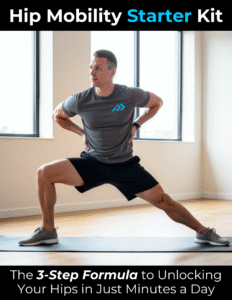

Rotator Cuff Exercises for Shoulder Pain Relief
The rotator cuff plays a crucial role in stabilizing and moving your shoulder, yet many people neglect it until pain or injury strikes. Weakness or tightness in the rotator cuff muscles can cause discomfort, limit mobility, and even lead to long-term shoulder problems. Whether you’re dealing with discomfort or aiming to prevent future issues, consistent rotator cuff training is essential for shoulder health and strength.
In this article, we’ll explore how to strengthen your rotator cuff using the Functional Mobility Formula, a proven system designed to provide lasting results. By incorporating the right rotator cuff exercises, you can improve your shoulder stability, reduce pain, and prevent injuries.
If you prefer videos, watch the video version below!
Understanding the Rotator Cuff
The rotator cuff is made up of four muscles—supraspinatus, infraspinatus, teres minor, and subscapularis—that surround the shoulder joint. These muscles work together to stabilize the shoulder while allowing smooth arm movements. Overuse, poor posture, or neglecting targeted rotator cuff training can weaken these muscles, making you more susceptible to pain and injury.
Strengthening your rotator cuff requires targeted rotator cuff workouts that focus on improving flexibility, range of motion, and strength. Adding these exercises to your routine can reduce pain, prevent injuries, and improve overall shoulder performance.
The Functional Mobility Formula
To effectively strengthen your rotator cuff, the Functional Mobility Formula offers a step-by-step system:
- Recognize
- Reduce
- Restore
- Reinforce
This approach not only targets rotator cuff pain but ensures long-term shoulder health and performance.
1. Recognize
The first step is identifying the source of your shoulder pain and the movements that aggravate it. For rotator cuff issues, pain is typically located near the ball-and-socket joint of the shoulder.
To recognize your baseline, try these movements:
- Shoulder flexion: Raise your arm straight overhead. Do you feel tightness, weakness, or pain?
- Shoulder abduction: Lift your arm out to the side. Many people with rotator cuff issues experience pain in this range, especially during mid-movement.
Documenting your baseline symptoms helps track progress as you work through your rotator cuff training program.
2. Reduce
The next step is to reduce tension in the rotator cuff and surrounding muscles. This prepares your shoulder for more intensive work and improves mobility.
A highly effective stretch is caudal glides, which target the rotator cuff and joint capsule:
- Sit at the edge of a bench or chair and grip the edge with the affected arm.
- Sit tall and lean your body away from your shoulder until you feel a gentle stretch in the top of the arm or shoulder socket.
- Repeat 10-15 times, leaning further with each repetition to increase the stretch.
This simple exercise helps relieve tension and improve circulation, setting the stage for deeper rotator cuff exercises.
3. Restore
Once tension is reduced, focus on restoring joint range of motion. The shoulder is a ball-and-socket joint with a wide range of rotational movements, making it essential to target these motions during rotator cuff workouts.
Shoulder capsule CARs (Controlled Articular Rotations) are perfect for this step:
- Raise your arm to shoulder height with your elbow bent at 90 degrees.
- Squeeze your fist, brace your core, and stabilize your body.
- Slowly rotate your shoulder in a controlled circular motion, keeping the movement isolated to the shoulder joint.
- If discomfort occurs, stay within a pain-free range and gradually expand your motion over time.
This exercise is a cornerstone of rotator cuff training, as it helps improve mobility while retraining the shoulder joint to move efficiently.
4. Reinforce
The final step is to reinforce the improvements you’ve made by building strength and stability in the rotator cuff. This ensures your shoulder can handle daily activities and high-intensity movements without risk of injury.
One of the most effective rotator cuff exercises for this phase is the sidelying shoulder roll:
- Lie on your side with your shoulder and elbow bent at 90 degrees.
- Pack your shoulder blade down and press your arm into the ground to lift your rib cage slightly.
- Slowly roll your shoulder forward, stretching the back of the joint.
- Press your arm into the ground to return to the starting position, repeating 8-10 times.
This exercise isolates the rotator cuff muscles, builds strength, and improves joint stability—all critical components of a well-rounded rotator cuff workout.
Reassess
After completing the Functional Mobility Formula, it’s important to reassess your baseline movements. Check if your shoulder pain has decreased and whether previously difficult motions, such as lifting your arm overhead, feel smoother and less restricted. If you notice improvement, you know your rotator cuff training is on the right track.
Why You Need Rotator Cuff Training
Incorporating a consistent workout for rotator cuff health is essential, especially if you engage in repetitive overhead movements or have a history of shoulder pain. Targeted rotator cuff workouts strengthen these stabilizing muscles, reduce the risk of injury, and improve shoulder function.
With proper rotator cuff exercises, you can build resilience, enhance athletic performance, and keep your shoulders pain-free for years to come.





